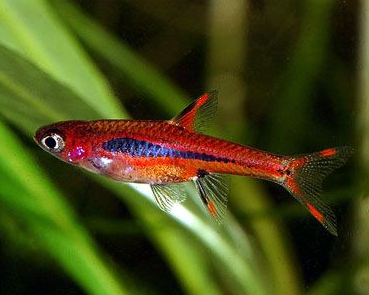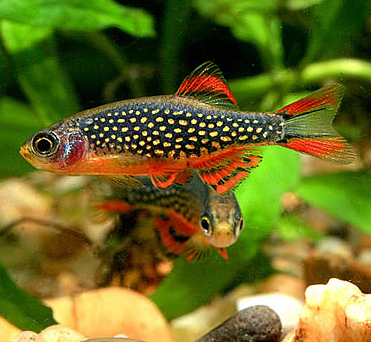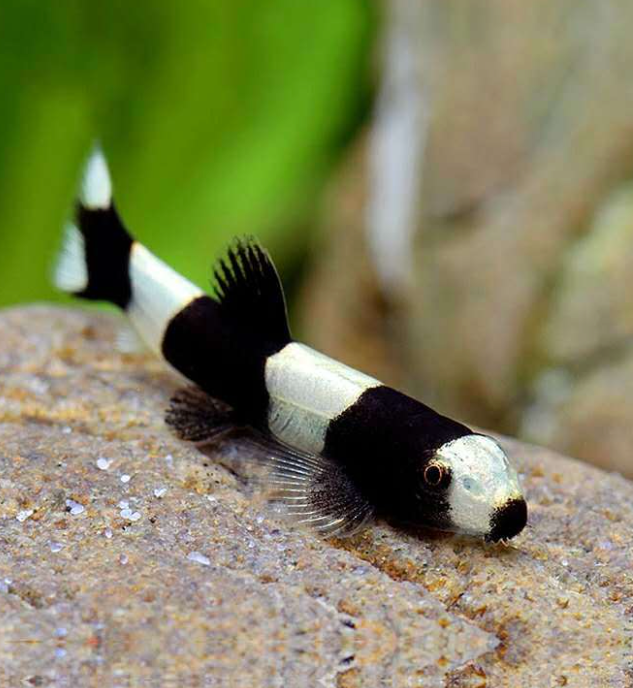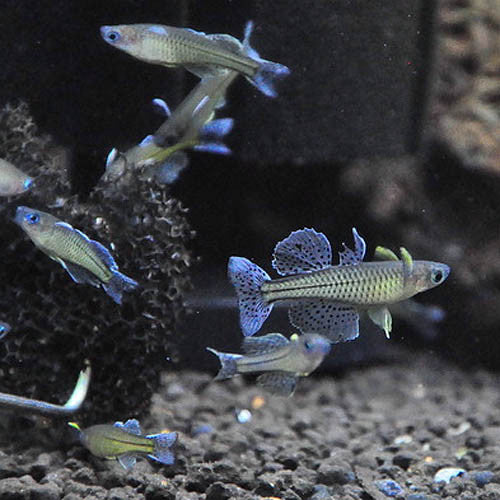Compatibility/Temperament: Peaceful shoaling fish, must be kept in a group of at least six but preferably more. Males will challenge each other, but without damage. Should not be kept with lively nor aggressive fish.
Diptail Pencilfish Diet
Accepts prepared foods from the surface that are small enough to fit the mouth. Carnivorous, in nature they feed on tiny insects at or near the surface, and small creatures on plants and underwater branches. Live food such as wingless fruit flies are a treat.
Size
Grows to 2 inches.
Minimum Tank Suggestion
18-24 inches
Water parameters for Diptail Pencilfish
Soft (less than 4 dGH), slightly acid (pH below 7.0), temperature 23-28C/73-82F. For spawning, the water must be softer (around 2 dGH) and pH 6.0 or lower.
Description
This interesting little fish is now frequently seen under the common name of Rocket Pencilfish, and sometimes Hockeystick Pencilfish.
A quiet, sedate fish well suited to a heavily-planted aquarium of gentle fishes; when housed with active fish, this species may be too frightened to eat. Floating plants will increase the fish's sense of security and also decrease the light which is very beneficial. It spends the day among plants and branches, searching for food; the mouth is forward (terminal) and always open, and designed such that the fish can easily pick up minuscule prey from plants and branches. This species swims in a head-up position, and remains in the upper half of the aquarium among plants and branches.
Nannostomus eques possesses an adipose fin, though it may be absent. In common with all pencilfish, except for N. espei, this fish has a diurnal colour pattern. During darkness, the horizontal lines break up into a series of dashes. This has been observed in blind fish, showing that it is an automatic response and not controlled by the fish.
Males are more slender than females, and the colouration of the fins is brighter. Will readily spawn but only in very soft, acidic water. The pair select a leaf and the eggs are deposited on the underside.
All pencilfish are found in the tribe Nannostomini in the subfamily Pyrrhulininae. Three different genera (Nannostomus, Nannobrycon and Poecilobrycon) were used at various times prior to Weitzman & Weitzman (2003). The subject fish was originally described as Nannostomus eques by F. Steindachner in 1876, using specimens from the Peruvian Amazon; the genus had been erected in 1872 by Gunther with N. beckfordi as the type. In 1910, C.H. Eigenmann assigned the present species to the genus Poecilobrycon which he had erected that year for the type species P. harrisoni [now Nannostomus harrisoni]. In 1950, Hoedeman proposed placing P. eques in his newly-erected genus Nannobrycon; the basis he used was the oblique swimming position and a peculiarity of the caudal fin, both traits unique to this species and N. unifasciatus [Hoedeman considered N. unifasciatus to be a synonym for the subject species]. He also alluded to a different shape of the swim bladder; Weitzman (1966) suggested that extensive anatomical study of all species in the tribe would clarify this point, but he opinioned that the oblique swimming position does suggest this.
In spite of the fore-going, Weitzman (1966) decided to place this species in Nannostomus, noting that future study might justify the two species N. eques and N. unifasciatus being moved to their own genus. Gery (1977) actually did this, but added no new evidence beyond what Hoedeman and Weitzman had mentioned. Weitzman & Weitzman (2003) listed all known species, including these two, in Nannostomus, and to date this has remained the accepted classification.
The name Nannostomus comes from the Greek meaning "small mouth," and Nannobrycon comes from the Greek meaning "small biter;" both names reference the small mouth of the pencilfishes.
Diptail Pencilfish Diet
Accepts prepared foods from the surface that are small enough to fit the mouth. Carnivorous, in nature they feed on tiny insects at or near the surface, and small creatures on plants and underwater branches. Live food such as wingless fruit flies are a treat.
Size
Grows to 2 inches.
Minimum Tank Suggestion
18-24 inches
Water parameters for Diptail Pencilfish
Soft (less than 4 dGH), slightly acid (pH below 7.0), temperature 23-28C/73-82F. For spawning, the water must be softer (around 2 dGH) and pH 6.0 or lower.
Description
This interesting little fish is now frequently seen under the common name of Rocket Pencilfish, and sometimes Hockeystick Pencilfish.
A quiet, sedate fish well suited to a heavily-planted aquarium of gentle fishes; when housed with active fish, this species may be too frightened to eat. Floating plants will increase the fish's sense of security and also decrease the light which is very beneficial. It spends the day among plants and branches, searching for food; the mouth is forward (terminal) and always open, and designed such that the fish can easily pick up minuscule prey from plants and branches. This species swims in a head-up position, and remains in the upper half of the aquarium among plants and branches.
Nannostomus eques possesses an adipose fin, though it may be absent. In common with all pencilfish, except for N. espei, this fish has a diurnal colour pattern. During darkness, the horizontal lines break up into a series of dashes. This has been observed in blind fish, showing that it is an automatic response and not controlled by the fish.
Males are more slender than females, and the colouration of the fins is brighter. Will readily spawn but only in very soft, acidic water. The pair select a leaf and the eggs are deposited on the underside.
All pencilfish are found in the tribe Nannostomini in the subfamily Pyrrhulininae. Three different genera (Nannostomus, Nannobrycon and Poecilobrycon) were used at various times prior to Weitzman & Weitzman (2003). The subject fish was originally described as Nannostomus eques by F. Steindachner in 1876, using specimens from the Peruvian Amazon; the genus had been erected in 1872 by Gunther with N. beckfordi as the type. In 1910, C.H. Eigenmann assigned the present species to the genus Poecilobrycon which he had erected that year for the type species P. harrisoni [now Nannostomus harrisoni]. In 1950, Hoedeman proposed placing P. eques in his newly-erected genus Nannobrycon; the basis he used was the oblique swimming position and a peculiarity of the caudal fin, both traits unique to this species and N. unifasciatus [Hoedeman considered N. unifasciatus to be a synonym for the subject species]. He also alluded to a different shape of the swim bladder; Weitzman (1966) suggested that extensive anatomical study of all species in the tribe would clarify this point, but he opinioned that the oblique swimming position does suggest this.
In spite of the fore-going, Weitzman (1966) decided to place this species in Nannostomus, noting that future study might justify the two species N. eques and N. unifasciatus being moved to their own genus. Gery (1977) actually did this, but added no new evidence beyond what Hoedeman and Weitzman had mentioned. Weitzman & Weitzman (2003) listed all known species, including these two, in Nannostomus, and to date this has remained the accepted classification.
The name Nannostomus comes from the Greek meaning "small mouth," and Nannobrycon comes from the Greek meaning "small biter;" both names reference the small mouth of the pencilfishes.





